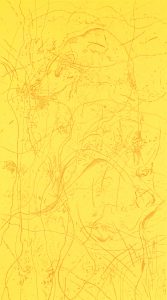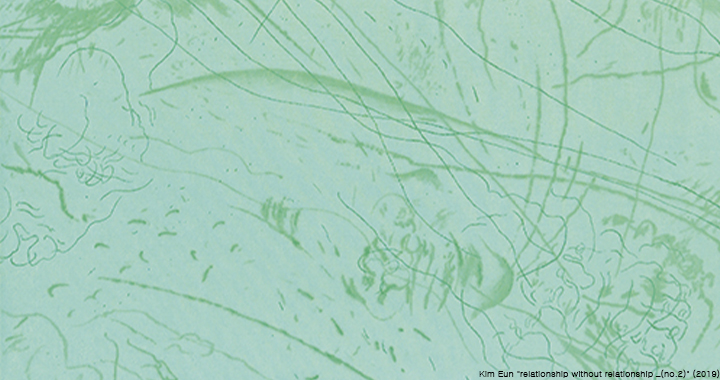May 27 – 31, 2020
2020년 5월 27– 31일
M Gallery, CICA Museum
무엇이라 부를 수 없는
Unnameable
나의 작업은 불안에서 시작된 것으로 작품의 바탕에는 인간 존재의 실존에 대한 사유가 깔려 있다. 물론 삶과 존재에 대한 물음에 정답이란 없지만 이러한 사유 과정은 자기 자신을 대면하는 성찰의 계기이자 창작에 대한 원동력이 되었다고 할 수 있다. 결과적으로 인간 존재에 대한 추상적이고 모호한 나의 시각은 몸의 해체된 형상으로 제시되고 있다. 작업을 진행하는 동안 동일한 존재를 중첩하고 해체하는 과정을 반복함으로써 대상은 층위가 불분명한 파편들로 점점 추상화되어 가며, 완성된 작품은 구상과 추상의 상호작용 안에서 경계의 모호성을 드러낸다. 또한 작업 과정 전반에서 일어나는 삶과 인간에 대한 존재론적 사유는 작업에 즉각적인 실험과 변화로 적용되며, 그에 따라 만들어진 작품은 미완의 가능성을 가지게 된다.
나의 실질적인 작업은 드로잉과 판화 매체를 사용하여 진행된다. 기법적 다양성과 우연성, 자유로움을 가진 두 매체는 다양한 실험의 장으로써 기능하며, 이를 통해 시각적으로 더 풍부한 이미지가 구현된다고 할 수 있겠다. 한편 화면에 그려진 대상은 나와 잠시 스쳐 지나간 타인으로, 관찰하고 드로잉을 하는 동안만 지속되는 일회적인 관계를 잠시 형성하게 된다. 그 짧은 시간 속에서 우리는 단지 드러내고, 발견하는 행위로서만 서로를 인식하고 바라보게 된다. 이후에 그려진 각각의 드로잉들을 하나의 동판에 중첩하여 제작하게 되는데, 날카로운 도구로 새겨진 판의 흔적들은 삶을 살아가면서 필연적으로 생겨나는 상처들이자 겹겹이 쌓인 시간의 층위를 나타낸다. 결국 나의 불안과 혼란은 나의 시선에 머물러있는 타인에게 투영되어 뒤엉킨 점, 선의 파편으로 가시화되었고, 그것을 판에 중첩하는 과정을 통해 재현된 대상은 점차적으로 해체되고 추상화되어 결국 무엇이라 부를 수 없는 흔적으로 표현되었다.
이처럼 나의 작업은 나 자신에게 감각되는 불안정한 존재의 잔상과 일회적인 관계를 판이라는 매개체를 통해 실재하는 흔적으로 만들어가는 과정이다. 흔적은 있음도 없음도 아닌 존재의 비확정성, 불완전성을 드러낸다. 불확실하고 유한한 삶을 살아가는 우리는 자신의 삶에 각자의 흔적을 남기고자 한다. 따라서 타인을 만나 관계를 형성하고, 이를 그리고 판으로 만들어 찍어내는 일련의 과정들은 본인의 삶에 유의미한 흔적을 남기고자 하는 실존의 방식이 된다. 상실되고 파편화된 몸의 형상은 익명적으로 존재하며, 주체와 객체의 경계가 없이 얽혀있다. 이와 같은 작품의 모호성과 가변성은 관람자로 하여금 자유로운 연상과 의미 생성을 가능케 하며, 인간 존재에 대한 사유를 유도해낸다.
인간 존재의 다층적인 의미를 해체된 몸의 형상을 통해 제시하고자 하였던 본인의 작품은 수많은 관계 안에서 직간접적인 영향을 받아 형성된 것이다. 자기 자신이라는 자아와의 관계, 나를 둘러싼 타인들과의 관계, 주변 세계를 포함한 수많은 존재와의 관계 안에서 우리는 공통된 세계 안의 흔적을 공유하고 이해하며 자신의 흔적을 남김으로써 세계에 참여한다. 또한, 작업 과정은 본인에게 자기 치유적인 행위로써 의미가 있다.
My work began with anxiety and is based on the contemplation for the existence of human beings. There, of course, is no answer to the question around life and existence, yet this contemplative process motivated my self-confrontational reflection and creative work. Consequentially, my abstract and obscure view on the human being is suggested in the shape of deconstructed bodies. By repetitively overlapping and deconstructing the same subject, it increasingly becomes abstracted as pieces with no distinct layers, and the finished work blurs the line between representation and abstraction through their interaction. Also, the ontological ideas on life and human occurring in the process of the work are applied as immediate experiments and changes, giving the work a possibility of incompleteness.
My practical work is done through drawing and printmaking media. These two media, with their technical variety, spontaneity, and liberty, function as fields for experiment through which richer images can be formed. On the other hand, the subject drawn in the canvas is a stranger, forming a one-time relationship lasting only during observing and drawing. In that short moment, we perceive and look at each other by nothing but revealing and discovering. I overlap each drawing on one copperplate afterwards. The traces on the plate left with sharp tools indicate the inevitable scars of living and multilayered time. My anxiety and confusion got projected on others in my eyes, materialized into entwined fragments of points and lines, through the work of overlapping them on the plate, the represented subject was gradually deconstructed and abstracted, ending up as an anonymous trace.
Like this, my work is a process of making the afterimage of my unstable existence sensed by myself and transient relationships into actual traces. Traces reveal neither presence nor absence, but the uncertainty and incompleteness of a being. We, living uncertain and finite lives, try to leave traces in each of our lives. Meeting others to form a relationship and printing them on plates, thus becomes a way of existence trying to leave a meaningful trace. The figure of lost and fragmented bodies exist anonymously, intertwined without the boundary between subject and object. The ambiguity and changeability of the work enable the viewer’s free imagination and creation of meaning, inducing a meditation on human existence.
My works, intended to suggest the multilayered significance of human existence through the figure of deconstructed bodies, were influenced directly and indirectly from numerous relationships. In the relationship with our own self (ego), with others surrounding us, and with countless beings including the ambient world, we share and understand the traces in our common world, as well as participating in it by leaving our own traces. The work process also has had a therapeutic significance to me.
작가 김은(b. 1984)은 현재 서울을 기반으로 작업하고 있으며, 홍익대학교 일반대학원 판화과에 재학중이다. 작가는 자신에게 감각되는 삶과 존재의 흔적에 대해 조명하고, 이를 드로잉과 판화 매체를 통해 시각화하는 작업을 이어나가고 있다. 최근에는 타인의 ‘몸’을 해체하는 방식을 통해 인간 존재의 불완전한 잔상을 판화의 흔적으로 남기는 작업을 진행하고 있다. 작가는 판화, 그래픽 디자인, 일러스트레이션 등 다양한 분야에 관심을 두고 있으며 각 매체의 응용과 실험을 통해 새로운 시각 언어를 구성하고자 노력하고 있다.
Kim Eun (b. 1984) is currently working in Seoul and studying at the Department of Printmaking at the Hongik University Graduate School. She sheds light on the existence and traces of life one perceives, visualizing them through drawing and printmaking. Her recent works focus on capturing the incomplete afterimage of the human being in the form of printmaking, through deconstructing the ‘body’ of others. The artist, taking an interest in various genres such as Printmaking, graphic design and illustration, is constructing a new visual language through experiments and applications of each medium.

Eun Kim, “relationship without relationship _(no.1)” (2019)
